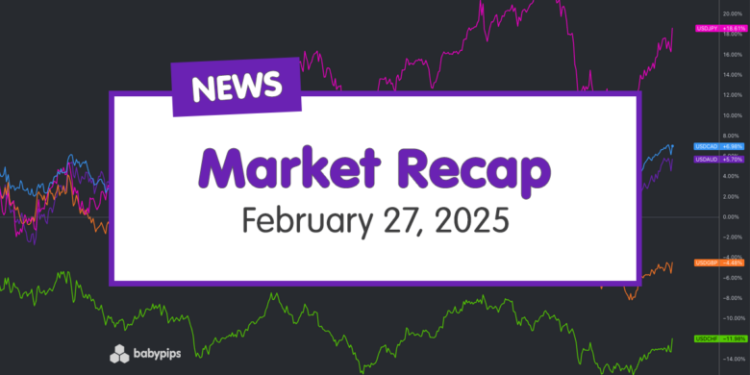The financial markets experienced a rollercoaster of emotions recently, as unexpected tariff announcements by President Trump sent ripples through investor sentiment. This resulted in a drop in stock values, a surge in the U.S. dollar, and surprisingly, a rise in oil prices triggered by concerns over supply constraints.
So, how did the markets respond to Thursday’s news? Let’s delve into the details:
Key Headlines:
- New Zealand’s ANZ Business Confidence for February 2025 climbed to 58.4, surpassing expectations that were pegged at 56.0, up from January’s 54.4.
- President Trump decided to revoke Chevron’s license to operate in Venezuela, which might pull approximately 240,000 barrels per day off the global oil market.
- The governor of the Bank of Japan, Kazuo Ueda, expressed concern over the unpredictability of U.S. policies and their implications for Japan’s economic stability.
- Switzerland’s GDP growth for the last quarter of 2024 was 0.2% quarterly and 1.5% annually, which fell short of analysts’ forecasts.
- The European Central Bank’s minutes from January highlighted a shift in inflation risk perceptions, prompting a reconsideration of future policy actions.
- Canada’s current account balance showed a deficit of $5.0 billion by the close of 2024, deeper than economists had predicted.
- In the U.S., durable goods orders saw a strong 3.1% rise in January, exceeding predictions, while core durable goods orders remained unchanged.
- U.S. GDP growth in the final quarter of 2024 was 2.3%, maintaining expectations but below the previous pace.
- Unemployment claims in the U.S. in late February reached 242,000, which was higher than anticipated.
President Trump also set the stage for a trade storm by imposing 25% tariffs on Canada and Mexico starting March 4, enhancing an existing 10% tariff on China, and warning of potential new levies on European products.
Market Reactions:
The volatility was tangible. The S&P 500 stumbled from its intraday peak near 6,000 to close at 5,861.57 points. Meanwhile, Nvidia’s stock plunged by 8.5%, despite a strong earnings report, largely due to rising competition from China’s DeepSeek. European markets echoed this downward trend, with the exception of the UK’s FTSE 100, which gained support from Rolls-Royce’s impressive results.
In contrast, oil prices defied the bearish mood, ticking up to $70.50 per barrel. This was largely fueled by concerns over the potential reduction in oil supply following the suspension of Chevron’s Venezuela license. On the other hand, gold prices dipped to $2,875, despite ongoing geopolitical tensions, while Bitcoin saw some recovery, trading around $84,400 after a brief drop.
U.S. Treasury yields for the 10-year note carved out a rise to 4.285%, snapping a succession of losses as investors took profits. The approaching end-of-month portfolio balancing further amplified market fluctuations ahead of crucial personal consumption expenditures (PCE) inflation data set for Friday.
Currency Market Dynamics:
The U.S. dollar demonstrated a mixed performance during the trading day, buoyed by various economic releases and Trump’s bold tariff announcements. Initially, the dollar strengthened on safe-haven appeal in the wake of comments from Japan’s central bank governor and lackluster Australian economic data. However, it faced some profit-taking and adjustments as Europe prepared for its data announcements.
Throughout the day, USD/JPY climbed due to increasing U.S. Treasury yields against Japan’s zero-rate environment. Swiss GDP figures triggered a slight reaction in USD/CHF, whereas the British pound pushed back against the dollar amidst optimistic trade talks between Trump and UK’s Prime Minister Starmer. The looming tariffs sent the Australian dollar reeling, reflecting its vulnerability to shifts in Chinese trade.
By the trading day’s conclusion, the dollar index rose by 0.8% to settle at 107.28, with investors repositioning in anticipation of the upcoming month’s inflation metrics.
Looking Ahead:
Potential catalysts on the calendar include Japan’s year-on-year housing starts, retail sales data from Germany, and key housing prices in the UK. Additionally, Switzerland and Canada are preparing to unveil retail sales and GDP figures, respectively.
Attention will also be centered on the U.S., where pivotal inflation and spending releases could heavily influence Federal Reserve decisions. Traders will be keen on any tariff developments, which could either inject fresh energy into risk appetites or send markets into defensive mode.
With month-end activity adding an extra layer of market dynamics, unexpected shifts are likely as sizable investors recalibrate their strategies. For traders keen on forex correlations, our new calculator tool can guide strategic decision-making.

















